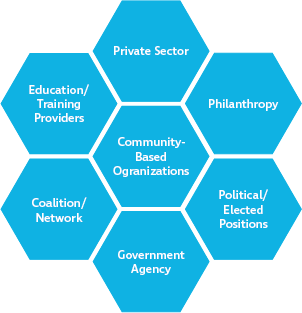Advancing Workforce Equity: A Guide for Stakeholders
Phase 2: Engaging Your Equity Workgroup
Key Decision Points• Workgroup Membership • Group Norms • Workforce Equity Definition |
Assembling an equity workgroup of like-minded people is exciting. But enthusiasm and goodwill, while indispensable to this process, are not enough. In this section, we focus on the necessary elements in planning your workforce equity initiative. Planning for your equity workgroup project is an opportunity to discover the plethora of opportunities available to you as you create a blueprint action.
The recommended size for a workgroup is 8-10 people. The members of the workgroup should be stakeholders from across the workforce ecosystem, for example, philanthropic organizations, local government officials, education and/or training providers, relevant coalitions or networks, private sector employers or business groups, and community-based organizations, and workforce development nonprofits.

This work is messy, challenging, and potentially triggering. Once you have assembled your workgroup, consider co-creating a set of group norms to keep you grounded and to hold members of your workgroup in “loving accountability.”
Equity Workgroups in Practice
Dallas
In Dallas, United Way of Metropolitan Dallas convened stakeholders from the community-based organizations, government agencies, philanthropic entities, and the private sector for their equity workgroup. They set norms on the importance of being present, mindful of language, and inclusive. They agreed to create a space that is safe and courageous and encourages people to share differences of opinion but laid out a clear decision-making process.
Seattle
From the beginning, the Workforce Development Council of Seattle-King County coordinated their workforce equity initiative with a broader strategic planning initiative. This meant that the equity workgroup was incorporated into an existing group of stakeholders that included council board members, community-based organizations and nonprofits, service providers, government officials, and higher education. They aligned the workforce equity initiative with a broader strategic goal to use data to identify disparate workforce outcomes by demographic group and implement population-specific strategies to eliminate disparities and address system barriers faced by those furthest from opportunity.
Defining Workforce Equity for Your Region
Also critical in this phase is to define workforce equity for your region. At the start of this guide, we offered a working definition of workforce equity. But the workgroup needs to define it for their region, and reach consensus around the definition, since it will serve as the North Star, guiding the data collection process (Phase 3) and influencing the development of strategies (Phase 4).
Once the group has defined workforce equity, it will work alongside the data partner to identify what’s driving workforce inequities in the region. The workgroup will establish geographical boundaries, select relevant indicators, and provide feedback and guidance to the data partner as necessary to inform the data exploration cycle.
Local Definitions of Workforce Equity
In the Advancing Workforce Equity initiative, each of the five participating communities created their own workforce equity definition. By defining it for themselves, the equity workgroups had a greater sense of ownership of the work and what they were trying to achieve.
Skillworks (Boston)
Where racial income gaps have been eliminated, all jobs are good jobs, and everyone who wants to work has access to family-supporting employment.
Chicagoland Workforce Funder Alliance (Chicago)
In an equitable workforce, race, ethnicity, gender, and other demographic characteristics no longer predict one’s outcomes in the labor market. All people have equitable access to jobs that are safe, pay a living wage, offer benefits, provide career pathways, and opportunities for mobility. The workforce – both public and private – is representative of the general population at all different levels of skill and pay across occupational groups and sectors.
To close the gaps, near-term efforts will be focused on communities most impacted by racial, ethnic, and gender disparities while working collaboratively to transform policies, institutions, and structures in the long term. Our strategies are systemic so that equity is permanent.
Pathways to Work (Dallas)
In an equitable workforce, race, ethnicity, gender, and other demographic characteristics no longer predict one’s success in the labor market. All workers are economically resilient and have equitable access to jobs that are safe, pay a living wage, offer benefits, and provide career pathways and opportunities for mobility. And, we eliminate disparities in compensation and employment for all demographic groups across all occupations and sectors.
To close the gaps, we center communities most impacted by racial, ethnic, and gender disparities to target improvements and to move beyond services to transform policies, institutions, and structures.
ReWork the Bay (San Francisco Bay Area)
We envision a diverse and equitable San Francisco Bay Area where everyone can (1) access quality, empowered jobs that allow them to benefit from and shape the region’s growing economy and (2) live full lives with security, dignity, and agency in our work, home, and communities.
Workforce Development Council of Seattle-King County (Seattle)
Workforce equity exists when all workers, regardless of race or ethnicity, have equitable access to high-quality jobs that provide safe and healthy working environments and offer opportunities for advancement and meaningful growth.
Take Action
- Using the results of your stakeholder analysis from Phase 1, invite your shortlist of potential equity group members to join the project.
- Convene your initial meeting with the equity workgroup.
- Co-create group norms.
- Determine a decision-making process.
- Define workforce equity for your project.
Related Tools
• Getting to Consensus
